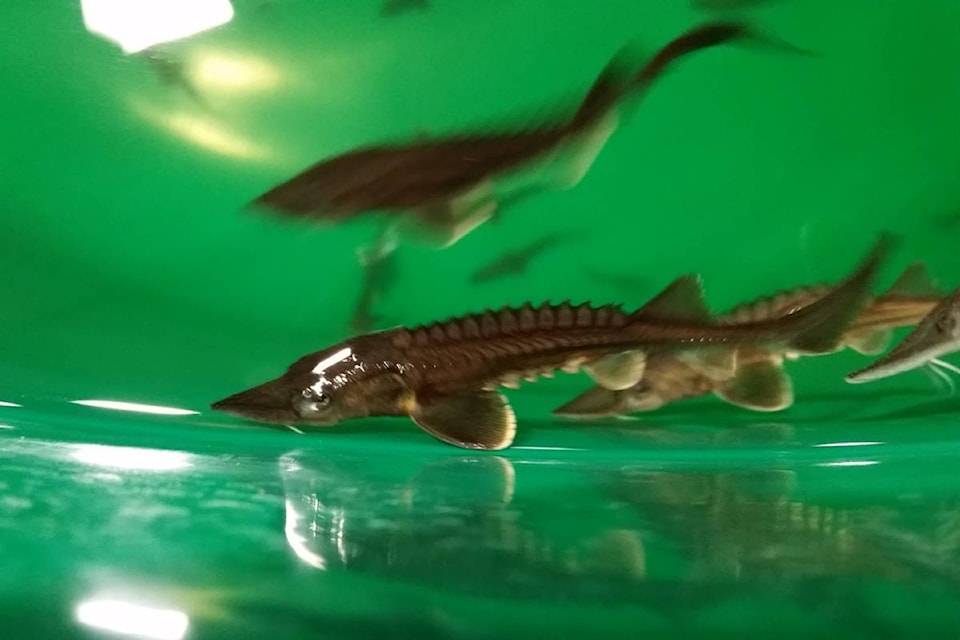With a greedy Vancouver-based otter as it feasts on expensive fish and evades capture, Vanderhoof has its own otter issues.
Nechako White Sturgeon, a species listed under federal government���߲��о����s Species At Risk Act (SARA) are being preyed upon by otter in the Nechako watershed.
Unlike in Vancouver, where there���߲��о����s just one troublesome otter, the SARA-listed sturgeon face a number of the predators, says Wayne Salewski, the chair of the Nechako White Sturgeon Recovery Initiative���߲��о����s Community Working Group.
���߲��о����I think we have families of otters who, like all good otters, like fish.���߲��о����
The sturgeon travel the length and breadth of the Nechako watershed, swimming as far north as Takla Lake and as far west as Stuart Lake, but always returning to a stretch of water downtown Vanderhoof to spawn.
The Nechako White Sturgeon Recovery Initiative in the city runs a hatchery, catching female and male sturgeon, stripping the eggs gently and returning the adult fish to the river, and then hand-fertilizing the eggs to raise juvenile sturgeon. The young sturgeon are later released into the river at nine different sites, some with radio transmitters in them, to allow the Initiative to track the fish and their survival rate.
Salewski says they���߲��о����ve discovered in the past few years that the juvenile fish are being preyed upon by otter in the river system.
���߲��о����Over the years we started to recognize that those fish with radio transmitters seemed to get preyed on quite heavily by otters. We���߲��о����d find that out by finding the radio transmitter up on the shore,���߲��о���� explains Salewski.
���߲��о����Most interestingly, we find a lot of these transmitters in the latrines of otters. Otters are very social animals, very clean, and they like the same bathroom sites.���߲��о����
Salewski says the otter don���߲��о����t ingest the transmitters, but eat around them and spit them out. Volunteers with the Nechako White Sturgeon Recovery Initiative are able to use their radios to find the discarded transmitters, which are reusable, says Salewski. ���߲��о����That���߲��о����s one good thing about the whole situation.���߲��о����
The group has now begun to put together a program to discover the impact the otters are making to the survival, and overall recovery, of the at-risk white sturgeon.
Salewski says it���߲��о����s been a learning curve from the start.
���߲��о����With every year of experience we are having to make changes in our practices to increase survivial. In the first few years, we would put a fish into the water at two to three inches in length. ���߲��о���� We could quickly see things like seagulls swarming our release sites and having a heyday. So that caused us to say, ���߲��о����Well, we will raise them bigger and that should look after that.���߲��о�������߲��о����
But the larger fish, at 12 to 14 inches, were excellent fodder for osprey and eagles, says Salewski.
���߲��о����No self-respecting eagle would go after a two-inch fish, but it would easily go after a 12- to 14-inch fish.���߲��о����
Now, the volunteers at the hatchery have decided to release the fish after two years.
���߲��о����That is our reaction. ���߲��о���� If otters are chasing these [12-inch fish], perhaps if they were bigger and faster, maybe an otter wouldn���߲��о����t challenge the idea of taking them on. That���߲��о����s where we are ���߲��о���� supersizing our fish and seeing if that gives us a better survival rate.���߲��о����
Salewski says the current low water levels aren���߲��о����t helping, as visibility is good for predators.
���߲��о����It���߲��о����s the circle of life. We are not naive, but there are many questions that are left behind. Are we in fact making otters healthier because they now have a constant supply of food? And will the healthy mommy produce more healthy babies and our problem will get larger because there are more of them? These are obvious questions and things that need to be answered,���߲��о���� says Salewski.
Find out more about the Nechako White Sturgeon Recovery Initiative .
READ MORE:
newsroom@ominecaexpress.com
Like us on and follow us on



